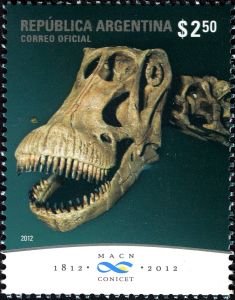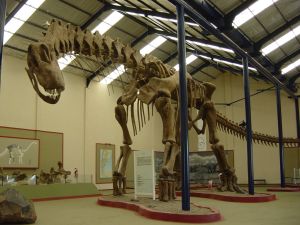Argentina 2012 "200th Anniversary of The Bernardino Rivadavia Natural Sciences Museum"
| <prev | back to index | next> |
| Issue Date | 28.04.2012 |
| ID | Michel: 3454-3457; Scott: 2653-2566; Stanley Gibbons: 3496-3499; Yvert: Category: pF |
| Designer | Photography of Mounting of elephant skeleton: Museum's Historical Archive. Butterflies and Birds Hall: Marcelo Ganevari. Dinosaur Bonatitan reigi: Angel Fusaro |
| Stamps in set | 4 |
| Value | 2,50 - assembly process elephant's skeleton 2,50 - "Bird Room" of the museum. 2,50 - entomological collection of the museum 2,50 - fossil of Bonatitan reigi dinosaur |
| Emission/Type | commemorative |
| Issue place | Buenos Aires |
| Size (width x height) | 2 stamps of 34x44 mm and 2 stamps off 44x34mm |
| Layout | Sheets of 20 |
| Products | FDC x1 |
| Paper | without any watermark, without any phosphorescence |
| Perforation | 13.75 |
| Print Technique | Offset, four colours, plus a metalized link |
| Printed by | Letra Viva SA, Buenos Aires |
| Quantity | 60.000 each stamp; FDC: 4.000 |
| Issuing Authority | Correo Oficial de la Republica Argentina SA |
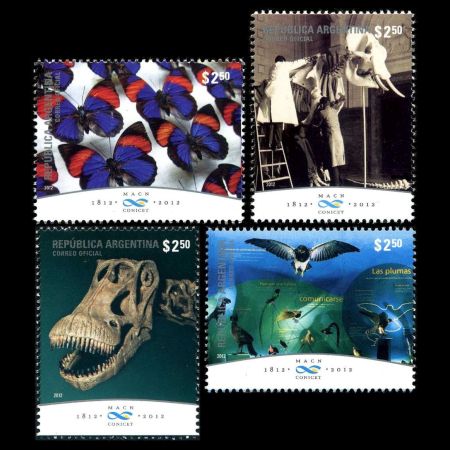
On 28 April 2012, Correo Argentino issued 4 stamps to commemorate the 200th Anniversary of the Bernardino Rivadavia Natural Sciences Museum.
The “Bernardino Rivadavia" Argentine Natural Sciences Museum (MACN — CONICET) is the oldest in the Argentine Republic. It was founded only two years alter the May Revolution in 1810; thus, its birth should be interpreted with regard to a national identity construction project as well as with the development of scientific history in the early Modern Age. The early years of the Museum coincide with a time when collectors gathered pieces of natural history and bright objects in what they called "curios cabinets”. These private collections originated herbaria and the zoological series that would later on be part of the museum's exhibits. During all those years, different personalities that lead the Museum gave their own particular style and vision to its management.
When Hermann Burmeister was named director in 1862 began a 30-year management that became the most significant in the Museum's history, due the magnitude of the implemented changes.
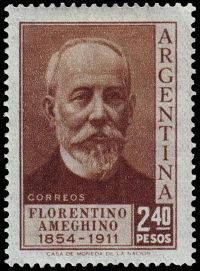
Great palaeontologist and the first Argentine director of the Museum Florentine Ameghino on stamp of Argentina 1956. MiNr.: 649, Scott: 658 |
In 1902 palaeontologist Florentine Ameghino became the first Argentine director of the Museum. In those times material started to saturate the buildings capacity up to a point that it became necessary to close its doors for lack of space. The Museum reopened in 1916. Under the direction of Martin Doallo-Jurado (1923-1946) the new building in Parque Centenario was built and the Museum moved into it. This innovative management centered on increasing collections, gave impulse to research and intense disclosure of knowledge.
In 1999 Dr. Edgardo Juan Romero assumed as director. In 2011 Doctor Pablo Tubaro its present director, started his management. New in 2012, the Museum's Bicentenary, the institution is working hard to achieve a new balance between research and museology. Collections are preserved and studied by specialized researchers and technicians. Research jobs are not only performed at the lab, but the researchers also hold study and material collection campaigns and advice other entities in Argentina.
The museum, the most important of its kind in Buenos Aires and second only to the La Plata Museum of Natural Sciences, nationwide. Besides the Natural Sciences Institute, the museum houses thirteen permanent exhibition halls, including an aquarium, a display with specimens collected from Argentina's numerous research stations in Antarctica, a geological collection centered around meteorites found in Argentina, a paleontology section notable for its Carnotaurus, Eoraptor, Herrerasaurus and Patagosaurus fossils, among others, and a Cenozoic paleontology display featuring Glyptodon, Macrauchenia, Megatherium and Smilodon fossils.
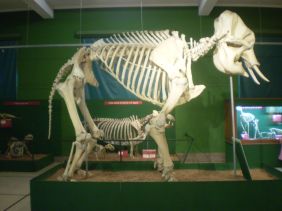 |
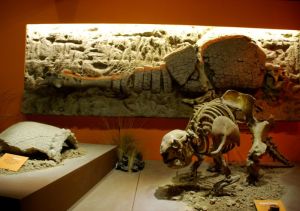 |
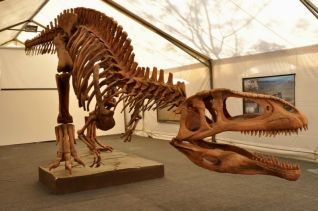 |
Images credit:
Wikipedia,
Photographs: Elephant - Claudio Elias, Glyptodon - Simona Cerrato, Dinosaur - Tecnopolis Argentina.
Academics and the general public can also avail themselves of a science auditorium, an art gallery, library and a cafe. This museum is the best place to entertain travel weary kids. They can let their imagination run wild here. There is something about seeing an 18 metre reconstructed Patagosaurus that concentrates the mind and ignites the imagination. The museum is a two floored building in the centennial park which houses dozens of our Jurassic friends on display as well as an impressive collection of stuffed animals (everything from Kangaroos and seals to monkeys and sharks) and a geology room filled with all manner of rocks.
| The stamps set includes four stamps: Photography of mounting on the ground floor of the Museum's building skeleton of elephant Dahila that died at the Buenos Aires City Zoo in 1943. View of the Museum's new Birds's Hall, inaugurated at the end of 2010. Frame of the showcase showing the different functions of feather. Butterflies of the Agrias narcissus species. View of one of the collections of the Entomology Division, that holds about 2.000.000 insects. | |||||
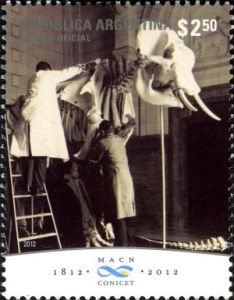 |
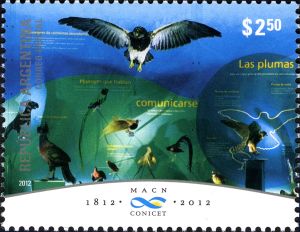 |
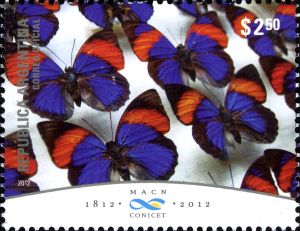 |
|||
The type species is Bonatitan reigi, first described by Martinelli and Forasiepi in 2004. The description is based on a partial skeleton, including a braincase and caudal vertebrae. Bonatitan is measuring about six meters long, 1.5 high and weighing three tons. Bonatitan genus is a tribute to Argentine paleontologist Jose Bonaparte and reigi species a homage to Argentine paleontologist Osvaldo Reig. Osvaldo Alfredo Reig, (14 August, 1929 - 13 March 1992), was an Argentine biologist and paleontologist. He was born in Buenos Aires, Argentina. He made numerous contributions in the fields of paleontology and biological evolution. |
|||||
Products and associated philatelic items
| Official FDC | Customized FDC | Booklet (PDF) |
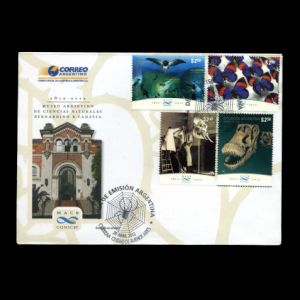 |
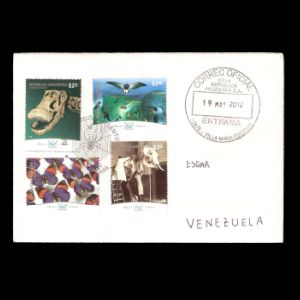 |
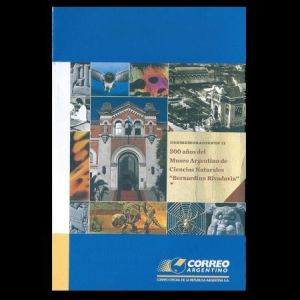 |
| The cover was sent from Argentina to Venezuela, three weeks after the stamps were issue. | ||
| Examples of Circulated Covers | ||
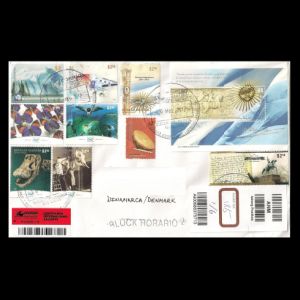 |
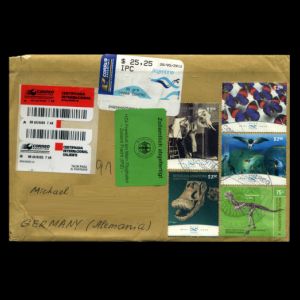 |
|
| Registered letter sent to Denmark. The stamps issued in 2014 used to complete the correct postal rate. | Registered letter sent to Germany. The fifth stamp, depicting fossil of dinosaur (Carnotaurus sastrei) is from Argentina 2001 set. MiNr.: 2691, Scott: 2167. | |

|
References
- Official press release and technical details: Bookletof Correo Argentiono, "Correo Argentino".
- Bernardino Rivadavia Natural Sciences Museum: official site (MACN), Wikipedia, Wander Argentina, "Buenos Aires Travel".
Acknowledgements
- Many thanks to Dr. Peter Voice from Department of Geological and Environmental Sciences, Western Michigan University, for reviewing the draft page .
- Many thanks to fellow stamp collector Jon Noad, from Calgary Canada, who shared a scan of the booklet with detailed description about these stamps.
| <prev | back to index | next> |
